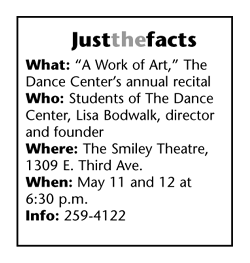| ||||
Apples, oranges, hip hop and jazz
by Judith Reynolds It’s easy to imagine almost any Renoir painting with the music of Dvorak playing in the background. But how about Edvard Munch’s famous “Scream” with Petey Pablo’s “Show Me the Money?” That’s a stretch. Stretching the imagination is what The Dance Center’s annual recital next weekend is all about. “A Work of Art” plays at 6:30 p.m. Friday and Saturday, May 11 - 12, at the Smiley Theatre. “In the past,” Director Lisa Bodwalk said in an interview earlier this week, “we had a theme like the history of film or the history of dance. Or ‘Greetings from America,’ based on different geographical settings. This year the recital isn’t linear at all. Despite the title, this is not the history of art. But we’ve been inspired by works of art.” With more than 200 performers from 28 different classes, the Center’s recital will be a whirlwind of short pieces. “The program is the culmination of a year’s work,” Bodwalk said. She and fellow teacher-choreographer Suzy DiSanto, who has been at the Center for seven of its 12 years, started by choosing the art. “Boy, it wasn’t easy,” Bodwalk said. “We started going through art books, but we didn’t find anything suitable before, say, about 1860. So we focused on the Impressionists and a lot of contemporary work.” Pairing Renoir with Dvorak seemed an obvious and safe choice, Bodwalk said. Pairing a nonobjective painting by Mondrian with the music of, say, the band Dee-Lite took a leap of faith. DiSanto jumped even further when she crafted a hip hop number inspired by Robert Rauschenberg’s “The Bicycle.” The music is by the Black Eyed Peas. “Degas begs for classical music,” Bodwalk said. “A painting by Jackson Pollock can have a harder edge. We decided to let the art evoke a style of music and went from there.” Images of each work will be projected on a screen, and audience members will recognize many, Bodwalk said. “But we’re not trying to represent the piece; we’re responding to it in dance.” Dancers range in age from 5 to late teens, Bodwalk said. “Then we have one group of adults from our intermediate and advanced tap classes who will dance to Peggy Lee’s ‘Fever.’ The artwork that inspired us is Alexander Steinlen’s ‘Le Chat Noir,’ ‘The Black Cat.’ It’s a great image – all tension, perfect for ‘Fever.’” In addition, dancers will interpret works by Cassatt, Cezanne, Dali, Kandinsky, Matisse, Manet, Monet, O’Keeffe, Picasso, Redon and Warhol, among others. To round out the student experience, Bodwalk organized an art project: “The theme is ‘Dance as Art,’” she said. “Students can submit work in any medium as long as it is less than 11-by-17 inches. So far we’ve received an acrylic painting, a paper collage, and pencil and pastel drawings. We’ll exhibit them in the lobby and award a ‘Best-of-Show.’” Given the theme, the visual projections, the musical choices and the art exhibit, the Center’s annual recital is a far cry from the old days of standard dances often repeated by more than one class. “I value dance education as a tool for learning,” Bodwalk said. “Learning about dance and art, yes, but we’re also learning about ourselves – how to know and express ourselves, and how to be effective in the world.” Chances are, you’ve never thought of pairing Van Gogh’s “Starry Night” with Mozart’s “Turkish March.” And it’s my guess that learning about artists such as Rene Magritte and Gustav Klimt will be new not only to the 5-year-olds. •
|
In this week's issue...
- May 15, 2025
- End of the trail
Despite tariff pause, Colorado bike company can’t hang on through supply chain chaos
- May 8, 2025
- Shared pain
Dismal trend highlights need to cut usage in Upper Basin, too
- April 24, 2025
- A tale of two bills
Nuclear gets all the hype, but optimizing infrastructure will have bigger impact



